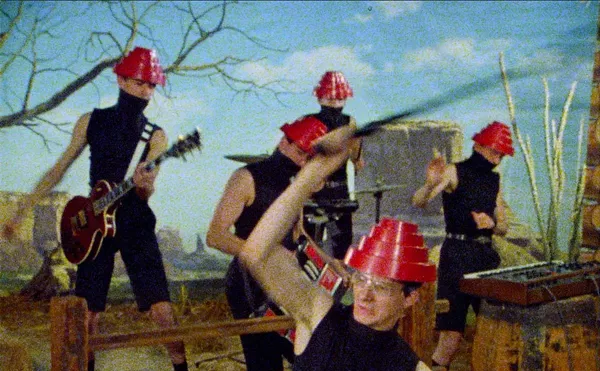Now is the winter of our discontent made glorious summer … something’s rotten in the state of Denmark … the course of true love never did run smooth … misery acquaints a man with strange bedfellows: We all know at least a few of the countless famous phrases penned roughly 400 years ago by William Shakespeare, even if we’ve no clue what Macbeth or Hamlet are all about. Today the playwright’s tricky prose is immediately recognizable if not understood, stamped into the modern collective consciousness by high school English teachers with a lust for rote memorization.
Audiences continue to buy tickets to see Shakespeare’s works despite the complexity of the repertoire, an archaic quality felt in every “wherefore” and “thy,” every stanza such as, “By envy’s hand and murder’s bloody axe. Ah, Gaunt, his blood was thine!” (King Richard II), phrases prosaic or evocative (depending on who delivers and directs them) yet so often confounding. Maybe it’s edification we seek, or perhaps a taste of that Shakespearean subculture.
Some scholars say several other writers had a hand in the 36 plays that became the backbone of theater as we know it. Though all the works attributed to Shakespeare were first produced in London, where his crew ran The Globe Theatre (at the time, the only stage in town), the literary giant himself came from Stratford-on-Avon, a lovely locale on England’s Avon River where the Bard was born in 1564 and died 52 years later. Details of his life remain one of literature’s great mysteries; the first Shakespeare biography was written 100 years after his death. For a man about whom we know so little, his legacy is nearly incomparable.
If you live in the Midwest, the place to feast on Shakespeare is Stratford, Ont., a charming town located conveniently on a river called the Avon. A three-hour drive from Detroit, it’s not a bad trip for a requisite dose of vengeful bloodletting, tragic madness and silly farce.
Stratford, 90 miles west of Toronto, has a natural allure for the curious wanderer (people optimistically compare it to Europe). But when I heard that The Stratford Festival of Ontario’s 2002 production of King Lear traveled to Broadway, where it was nominated this year for two Tony Awards, I decided to investigate. I had simple questions: Is a journey to Stratford worth the travel and theater admission prices, and can you do the trip on a budget?
The answers came easy: yes and yes. Of course, the “cheap” factor depends on you — how comfortable you want your overnight accommodations, whether you’ll partake in some of the town’s great restaurants and how much theater you want to see: Tickets run from $30 to $120, and those on the lower end of the spectrum are for limited shows. (For more on ticket prices and deals, visit the festival’s Web site.)
Even if theater isn’t your thing, a trip to Stratford is well worth the time and money. It’s a relaxing getaway — perfect for lovers, manageable for families, entertaining for a cast of friends. The town has all sorts of outdoor art and music events and is covered with lush gardens, including one in which all the roses, herbs and flowers of the Bard’s plays bloom.
A high point is finding and chilling on a grassy knoll along the Avon, a slim, mellow river lined with riparian finery, with meadows of kids and men playing soccer and little bridges and swans and ducks and walking trails and enough romance to make you pucker.
Stratford boasts more than 200 bed and breakfasts and numerous shops and restaurants to support its year-round population of 28,000. Despite its working-class roots (the auto parts manufacturing industry is the main employer), the place is strictly non-smoking, even in bars.
I went with two girlfriends and we came home after three days relaxed, well-fed, sunned and adequately edified. None of us would have wanted to stay a moment longer, but that’s what makes it a good weekend getaway.
A Midsummer’s Hamlet
Every year the festival weaves a schedule of Shakespearean productions with Broadway musicals, Canadian plays and dramatic classics. The productions open and close over the course of the season, from May to November. In three days, we saw five plays — more than I’d recommend. By the time Macbeth rolled around at 8 p.m. Saturday night, we’d had our fill of drama.
Shakespeare is difficult to do well, and most of us have seen it modernized, deconstructed and attempted in its pure form to varying degrees of soporific effect. To see it done with passion, knowledge and a dedication to excellence is a treat, and that’s what Stratford offers. The festival trains its company members in classic acting and it shows; these people know how to deliver their lines.
Each of the Shakespearean plays I saw — Macbeth, A Midsummer Night’s Dream and Timon of Athens — were powerfully interpreted.
Stratford’s Macbeth was aptly gruesome, cruel and insane. Graham Abbey, a Stratford regular in playing romantic leads, was superb as Macbeth, embodying all the rage and confusion of a man possessed by a power-hungry wife and driven mad by his murderous acts. By the end of the play, the guy is so far gone he spits as he delivers his lines. It led me to conclude: the more spittle, the better the play.
Lucy Peacock, having just returned from Broadway where she played Regan in King Lear, was fierce as Lady Macbeth, a woman driven mad by her bloody ambitions. When Lady Macbeth appears dressed only in a long white fur coat on a stage draped for the scene in a white silky cloth, it’s bloodcurdling.
The witches were wonderfully creepy, and when the play opens in a post-battle scene with dead and mangled bodies onstage, you can almost smell the blood and gunpowder. The swordsmanship at the end of the play left the audience gasping.
This is how Shakespeare is supposed to be done; I was buzzing when the curtain fell.
Midsummer had the benefit of a gorgeous Amazon rainforest-inspired set replete with a surreal sculpture of twisted metal that served as a stage above the stage, and the fairy costumes were entertaining in themselves. The production was lucky to have circus instructor Anaïs Guimond, who trained with Cirque de Soleil. The bungee-twirling, spinning and flying acrobats added much to the experience.
But the story failed to capture me. It redefines silly, as four youngsters run away into the forest where fairy dust causes everyone to be in love with the wrong person. It’s pointless. There are some true comedic points — the cast does its best with what it has to work with — but I found the hammy comedy grating, especially watching Nick Bottom, played to the hilt by actor Thom Marriot, as he becomes an ass beloved by a drugged fairy princess.
The Three Stooges-esque slapstick gave me a headache. I couldn’t help but think that this sort of thing would be entertaining if we didn’t have television or movies or … well, we do.
Jonathan Goad and Dana Green as Oberon and Hippolyta were strong and beautiful. It was enchanting to see their sculpted, painted bodies lilt across the stage, looking nearly naked.
Timon is rarely done, but I found the story as intriguing as Macbeth, if not as bloody or poetic. It’s the tale of a wealthy man who lavishes so many gifts upon his friends he ends up broke. When he asks these friends for help, they balk. Insane with anger and disgusted at human nature, he flees to a woodsy hermitage, where he has a couple unexpected turns of fate — but it’s the characters’ musings on flattery, friendship and wealth that fuel the play.
Stratford dresses Timon actors in modern garb, but sticks to the text as written: strong choices.
I arrived uninterested in Stratford’s non-Shakespeare theater — I wanted the meaty, smart stuff. But after seeing Count of Monte Cristo and Guys and Dolls, I wished we had signed up to see Anything Goes and Noises Off as well. The sets, staging, acting and music were Broadway-quality, filled with enough action, comedy and drama to keep the audience mesmerized.
Count of Monte Cristo is an 1844 romantic thriller by Alexandre Dumas. Stratford’s production plunges you immediately into a richly textured environment of pirates, sailors, political intrigue, love, loss, betrayal and revenge in the age of Napoleon. The play opens with an astonishingly authentic storm-tossed ship at sea.
Guys and Dolls, a play made famous by the movie of the same name starring Frank Sinatra, features a sleazy tale of gambler Sky Masterson and the straight-laced Salvation Army girl Sarah Brown. The song and dance numbers are infectious; the production has been so well-received that Stratford is extending its run.
Getting there
The drive to Stratford took us past electric green and yellow fields. The trip was a snap. Just as the rolling farmlands grew tiresome, little towns dotted the final leg. Take I-75 to the Blue Water Bridge in Port Huron. Once in Canada, take Highway 402 to exit 65, which is Highway 81. Go left (away from Strathroy) along 81 until you get to Regional Road 19, which branches off to the right. Be careful — the sign was missing when we went and we missed the turnoff. Once in Ailsa Craig, take a right on Highway 7, which turns into Erie Street in Stratford and will take you to the main road, Ontario Street.
Grub/libations
Upon arrival downtown, we parked on the main drag, Ontario Street, and found a café for a cold one. We stumbled fortuitously upon Down the Street, a restaurant/bar that greeted us with outdoor seating ringed with flower baskets. The upscale pub should win an award for best place with the worst name — it became our home base. The food and atmosphere are elegant and superb with a Continental taste; people sit at little tables drinking and eating foods made with the freshest ingredients from lunch until late at night, when actors from the plays show up and the café transforms into a bar scene.
The salads and dinner entrées were the best we ate in Stratford, including an interesting Moroccan dish of roasted root veggies and couscous and a succulent steak with sautéed mushrooms and awesome “frites” — a standard in Stratford. Our first taste at Down the Street was of the most scrumptious chocolate cheesecake ever; crafted by a skilled hand, it was a masterpiece of chocolate, cheese, cream and berries — every bite a sin. It’s not the cheapest option, but well worth the extra you will pay — lunch runs $12-$20 Canadian, and dinner entrées start at $18 Canadian, or roughly $9-$15 and $13 U.S., respectively.
Quickly we noticed throughout Stratford that organic, locally grown greens and vegetables are the norm. The streets are lined with window boxes sporting vibrant herbs and greens, and fresh local cheeses are also offered. The selection of eateries is great — you can go entirely on a low-cost budget with offerings such as Curry On, an Indian joint with some $4 dishes, to the more upscale offerings of the many restaurants in Stratford run by local chefs. Everything we ate was very good.
The prices reflect what you will find around Detroit, except better food is cheaper. We had fish and chips for $9 Canadian, chicken tenders for $8, and it’s easy to find a glass of wine for $6 Canadian. At the Queen’s Inn, 20-ounce imported beers are $5 Canadian.
If you can afford a step up in price from Down the Street, The Church is a beautiful restaurant in an old church with such offerings as lobster bisque and broiled salmon. The food isn’t as good as Down the Street, but the atmosphere is compelling.
After taking a yoga class Friday morning in a studio downtown, we headed, famished, to Bijou Bakery and Café, a healthy breakfast/lunch spot offering fresh artisan breads, imported cheeses, creative sandwiches and homemade soups. It’s a must.
Other places to check out include:
York Street Kitchen, a local favorite serving soups and salads and sandwiches on great breads. We had three huge delicious sandwiches, shared a bowl of soup and got two iced teas for $36 Canadian.
The Principal’s Pantry, a nice little cafeteria outside the main theater, offers all sorts of food and beverages: For $20 Canadian we had two glasses of wine, a latte and two chocolate chip cookies.
The vibe
The people in Stratford are cordial, if not chatty. This is a good thing, unless of course it’s your business to ask lots of questions and start random conversations.
As for the feel of the place, it’s a bit frumpy — not very hip. The restaurants are beautiful, but the shops offer mostly pricey suburban boutique fare. Most of the festival-goers are either 60 and counting or members of the high school drama club. Many young Goths were in attendance, providing a nice all-black backdrop to the throngs of men and women in pleats and sandals. It’s a chilled-out, wholesome theater crowd.
At our bed-and-breakfast were visitors from Toronto and Chicago; the bulk of visitors every year comes from Michigan. I met a lady who didn’t want to give her name but says that she and her friends from Grosse Pointe are groupies of Graham Abbey and come to see him every year.
The town is lovely and walkable but feels more like a posh suburb than a medieval European town; many of the houses date to the 1840s, but the downtown facades are fairly new.
Resting
The rumor is that one must book rooms months in advance; not so. For the best deals on the best places, of course, book early. I called 10 days before my departure and had my choice of lodging.
We stayed at The Maples of Stratford, a stately Victorian bed-and-breakfast located 15 minutes on foot from downtown. The bill came to roughly $33 U.S. per person per night, including a very good breakfast. The place was a bit uptight for my taste — more a formal place to sleep and less a place to hang out, yet affordable and convenient. Some of the other guests drank wine and played Scrabble on the porch while looking at the tree-lined street. The beds sported insanely soft sheets, but we shared a bathroom with other guests.
The Garden Place bed-and-breakfast is even closer to town and boasts a gorgeous perennial garden with sitting areas, at least four housecats, a piano/music room and a library feel throughout. It’s more expensive — its cheapest room is $145 Canadian — but definitely worth it during the warmer months if only for the soothing garden. All rooms have a bathroom.
Because of the volume of inns ranging from $20 per night for a hostel-like setting to elegance fit for Madonna, it’s a good idea to call the Stratford Accommodations Bureau. That’s how I got my reservation. The people at the bureau are incredible. Tell them what you’re looking for and they work hard to find it, and can make the bookings for you. The festival is wise to offer such a useful service. Call the bureau at 1-800-567-1600.
In town, there are tons of other things to do, such as touring the costume factory (a tour I found boring because most of the costumes were on hangers) and neat day trips. For nearly all you could possibly want to know about Stratford and the festival, visit stratfordfestival.ca, where you can buy tickets online, order a free visitor’s guide and get information on lodging, food and activities.
Lisa M. Collins is the arts editor of Metro Times. Send comments to [email protected]





